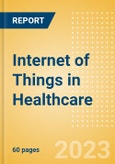Digital transformation has been a steady trend within healthcare for several years. IoT-enabled technologies such as electronic health records, remote patient monitoring, and wearable devices streamline the patient experience and give patients greater agency in their care.
The COVID-19 pandemic made the need for IoT more pressing as healthcare providers were forced to enact social distancing policies and cope with staff shortages and patient backlogs while mandated to provide the same quality of care or better. The accelerated integration of new and existing digital technologies allowed healthcare systems to expand their services to meet the challenge of COVID-19. Although the pandemic was declared over on May 5, 2023, the need to address staff shortages and aging demographics will drive the adoption of IoT-enabled solutions in healthcare throughout the 2020s.
The COVID-19 pandemic made the need for IoT more pressing as healthcare providers were forced to enact social distancing policies and cope with staff shortages and patient backlogs while mandated to provide the same quality of care or better. The accelerated integration of new and existing digital technologies allowed healthcare systems to expand their services to meet the challenge of COVID-19. Although the pandemic was declared over on May 5, 2023, the need to address staff shortages and aging demographics will drive the adoption of IoT-enabled solutions in healthcare throughout the 2020s.
Key Highlights
An overview of the trends impacting IoT adoption in the healthcare sector.IoT technology briefing
Case studies showcasing how companies in the healthcare sector are adopting IoT.Scope
- This report provides an overview of IoT in healthcare.
- This report explains why IoT will continue to grow in importance for the healthcare industry.
- This report outlines how the correct IoT strategy can enhance pharmaceutical, medical devices, and healthcare companies' ability to draw insights from an increasingly large volume of data sets, allowing for more timely decision-making.
- The investment opportunities in the IoT value chain are covered.
- The report also provides an overview of IoT activity relating to the sector, including tech vendors and industry adopters.
Reasons to Buy
- Determine potential investment opportunities based on trend analysis and market projections.
- Gaining an understanding of the market challenges and opportunities surrounding the IoT theme.
Table of Contents
- Executive Summary
- Players
- Healthcare Challenges
- The Impact of IoT on Healthcare
- Case Studies
- Market Size and Growth Forecasts
- Signals
- IoT Value Chain
- Companies
- Sector Scorecards
- Glossary
- Further Reading
- Thematic Research Methodology
- About the Publisher
- Contact the Publisher
- Challenges
- M&A
- Leading IoT adopters in healthcare
- Specialist IoT vendors in healthcare
- Glossary
- Further reading
- Key players in IoT in healthcare
- IoT-related social media concepts in healthcare
- Thematic impact assessment for pharmaceutical companies
- Thematic impact assessment for medical device companies
- Thematic impact assessment for healthcare providers, payors, service providers, and suppliers
- Global healthcare IoT market revenue, 2019 - 2027
- Geographic split of global healthcare IoT market revenue, 2027
- Top 10 companies ranked by IoT-related patents in healthcare, Jan 1, 2020 - Sep 30, 2023
- Active IoT-related jobs trends segmented by sector, Jan 1, 2020 - Sep 30, 2023
- IoT mentions in healthcare on social media, Jan 1, 2020 - Sep 30, 2023
- Polls and surveys
- The IoT value chain
- Scorecards
Companies Mentioned (Partial List)
A selection of companies mentioned in this report includes, but is not limited to:
- Roche
- Pfizer
- Novartis
- Sanofi
- AstraZeneca
- GSK
- Merck
- Viatris
- Biocad
- Sun Pharma
- Intas
- Generium
- Perrigo
- Medtronic
- Philips
- GE
- Abbott
- DexCom
- Biotronik
- Thermo Fisher Scientific
- Smith & Nephew
- Danaher
- Bupa
- Cleveland Clinic
- Mayo Clinic








